The rise of
nVIDIA's nForce2 chipset as top dog among AMD chipsets has
been nothing short of remarkable. So swift was the momentum of this chipset
that only now are VIA and SiS catching up.... to silicon which has been
around for over eight months now. That is just about a full life cycle in the computer industry.
If you
were to ask anyone which new AMD motherboard to get, you'd no doubt be recommended
to get something using one of the nForce2 variants! There's good reason for this
blatant nForce2 loving; nForce2 based motherboards are extremely fast and stable. Until the
recent blip with the 2.41 and 2.42 unified drivers, nVIDIA hadn't had a any significant
compatibility or driver problems.
With the release of VIA's new KT600 chipset the nForce2
finally has some real competition to face up against. The competition will be
tough for VIA since their chipset is hardly even battle tested, let alone proven
in the minds of AMD's consumers. Knowing VIA though, they'll need to rehash
the KT600 before things are done right.... you can almost bet that somewhere
on the horizon there is a KT600A.
Now back to the good stuff! Today on PCstats.com we're
testing out the Magic-Pro K7N-Ultra S nForce2 SPP based motherboard. While a
relatively unknown brand here in North America, Magic-Pro is not a
new company. They've been around since 1987 and have mainly been focusing on the
asian market where they're known for selling competitively priced components, largely we
suspect, from other OEM vendors.
With a retail price of just $155 CDN ($100 US) via
Canada Computers, the Magic-Pro K7N-Ultra S is one
of the least expensive nForce2 SPP boards on the market that we've come across.
Of course, just because it's priced low doesn't mean it doesn't have
any features. The board includes 5.1
audio (not nVIDIA's SoundStorm, AC'97 software codec), 10/100 LAN and Serial ATA\Serial ATA
RAID.
Magic-Pro also include
five PCI slots on their flagship K7N-Ultra S should you need to
expand a few months down the road. Of course, there are the usual 8x AGP port
and three DIMM slots which support a maximum of 3GB of PC1600/2100/2700/3200 DDR
RAM.
| magic-pro
k7n-ultra s motherboard |
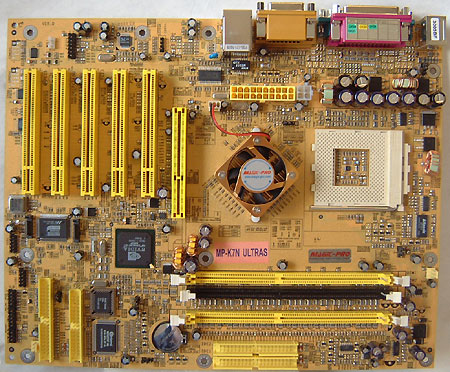
 |
Ships with the following:
- IDE ATA66/100 Cable
- FDD Cable
- 2x Serial ATA Cable
- Driver CD
- User Manual
- I/O Back Plate
- Serial ATA/RAID Driver
- Misc Programs Manual
- Programs CD
|
| Brackets: N/A |
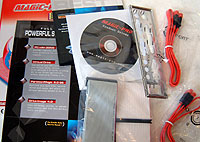 |
In case you were wondering, yes, the Magic-Pro K7N-Ultra
S and the Soltek 75FRN2-RL look identical and share
the same feature set.
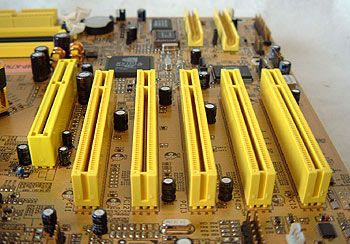 These two
boards like and seem identical because under the MP-K7N UltraS sticker we fined the "Soltek" name silk screened onto the PCB.
These two
boards like and seem identical because under the MP-K7N UltraS sticker we fined the "Soltek" name silk screened onto the PCB.
Meaning
that Magic Pro have OEM'd the board from that company and simply relabeled
and packaged it with their own
bundle of extras. Well, if you're a Soltek fan at least we know what to expect in terms of build quality.
The K7N-Ultra S has a bright yellow PCB with matching AGP/PCI, DIMM slots as well as main ATX and IDE/Floppy drive connectors.
The main IDE connectors are in the prime location to the right of
the DIMM slots. Because the nForce2 Northbridge generates quite a bit of heat,
we were pleased to see
Magic-Pro decided to go with an active cooler, and use a fair amount of silicon thermal paste.
I'm not a fan of placing the power connectors near the rear I/O ports but I do
understand that that's the best way to get clean stable power to the
motherboard. Magic-Pro also utilizes the ATX12V power connector which is a good
idea since the Athlon processor gets its power from the 12V line.
What I don't like...
Like the nForce2 Northbridge, the MCP/MCP-T Southbridge also generates quite
a bit of heat. It would have been nice for Magic-Pro to follow the lead of other
manufacturers and place a small passive heatsink on the Southbridge. These days
only having two USB ports can be a real hassle so we were a bit disappointed to
see Magic-Pro did not include any USB port bracket.
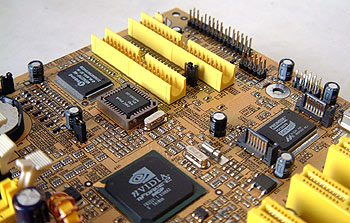
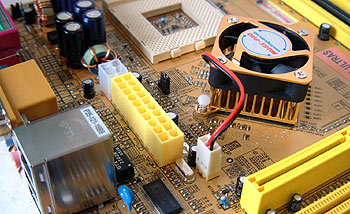
The Magic-Pro K7N-Ultra S was not quite as well
labelled as some of the other motherboards we have tested in the past,
novice users may have a bit of difficulty installing the board or configuring the
jumpers. Also keep in mind that there are no mounting holes around the CPU
socket.

